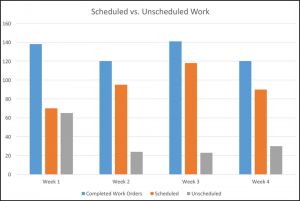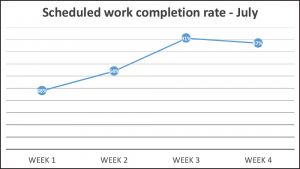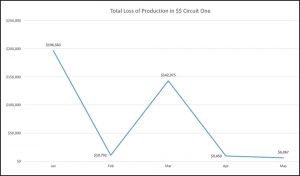No doubt you have heard these terms, read articles and attended workshops and seminars to learn about these strategies. Using this information, you’ve discovered which ones will make your maintenance program more effective, reduce labor hours, reduce costs, increase equipment availability and ultimately improve production.
Based on experience gained from being around maintenance shops for many years, visiting with people in a variety of industries and talking with maintenance professionals around the globe, the conclusion formed is: There is a right time and a right place for each of these strategies.
Preventive Maintenance
For years, maintenance professionals relied on preventive maintenance strategies to take action on a prescribed interval, such as days, hours, miles or tons hauled. On a predetermined interval, they took action to drain and fill oils or replace an engine, transmission, or gearbox. They did so without regard for the condition of the oil or whether or not the component was running well. The thought was, if you maintain it on a time based interval, you won’t have to work on it tomorrow as an unscheduled event.
Predictive Maintenance
Then came a time when maintenance shifted toward a predictive or conditioned based strategy. This approach requires the use of nondestructive, noninvasive testing, such as vibration analysis, thermal imaging, ultrasound and oil analysis. It also includes monitoring work order history, the number of operator complaints, dollars spent on minor repairs and the frequency of those repairs.
One might look and immediately come to the conclusion that predictive maintenance is the strategy that should be followed. After all, “If it isn’t broke, don’t fix it!” However, there are times when a predictive maintenance approach might not be the proper method.
Let’s look at a scenario of a gear pump in a minor circuit or as a support piece of equipment. In this scenario:
- The oil capacity is minimal.
- Oil changes are easy to perform and are not labor intensive.
- The cost of the gear pump replacement is minimal.
- A replacement gear pump is readily available.
- There will not be a significant impact to production.
- There are no safety concerns associated to the failure.
Do the benefits of predictive maintenance outweigh the run to failure or preventive approach?
Would following a predictive maintenance strategy be the correct choice, or should you, perhaps, consider a run to failure or preventive maintenance strategy?
In this scenario, it is important to consider the cost of nondestructive testing and the labor hours involved. The question to consider is: Do the benefits of predictive maintenance outweigh the run to failure or preventive approach?
On a side note, a strictly predictive approach offers some challenges, compared to a preventive approach, when trying to forecast and prepare next year’s maintenance budget. That, however, is a topic for another day.
Proactive Maintenance
The proactive maintenance approach can be used in combination with any of the other maintenance strategies, although many would argue that this is a “stand-alone” maintenance strategy. With this approach, you look at the root cause of both impending failures and an analysis of failures that have already occurred. You look beyond symptoms and look at root causes, such as incorrect lubricants, faulty rebuild practices specific to the part of the rebuild procedure that was incorrect, contamination control practices, etc. You then focus on a remedy for these root causes for the purpose of extending component life hours and preventing future or catastrophic failures.
Run to Failure
While on the surface it does not sound like a “strategy,” run to failure can be the correct maintenance decision in some circumstances. For components that are at the end if their lifecycle, you simply want to get every hour of operation out of the component as you can, and you are not concerned with loss of core. If this is a route you choose, you will want to ensure you are prepared with a replacement already on-hand and willing to accept the risk of the disruptions in scheduled maintenance that is likely to occur when the failure happens. If this is a strategy you choose, keep in mind that nondestructive testing, such as fluid analysis, can still be very useful in helping predict when the failure will occur.
Reactive Maintenance
Every maintenance professional would like to greatly reduce or eliminate reactive maintenance, that unplanned, unscheduled event that catches you by surprise and disrupts everything you had planned for the day. This type of maintenance often leads to a visit from an unhappy owner, operations superintendent, plant manager, or customer. Despite all your efforts of preventive, predictive, or proactive maintenance, these unplanned events happen regardless of which maintenance strategy, or combination of strategies, you decide upon. Reduction in reactive maintenance events is your goal and you should pursue a path of continuous improvement.
How to Decide Which Maintenance Strategy Is Best for Your Organization
First, it is important to do an honest evaluation of how well your current maintenance program is performing and identify the areas that need improvement. Evaluate a few of the major maintenance repairs you routinely perform today. Then, perform a cost analysis of an average cost of repair under a scheduled/planned event in comparison to an unscheduled, reactive maintenance event.

Figure 1: Cost analysis example of an engine repair in a long-haul truck
Figure 1 is a cost analysis example of an engine repair in a long-haul truck. Under the scheduled repair scenario, oil analysis results alerted maintenance of abnormal early stage bearing wear. The driver was immediately contacted to return to a local maintenance facility and maintenance repairs were scheduled and performed. The cost of these repairs were then compared to a scenario where the truck continued to run until there is oil pressure loss and the driver notices the check engine light is on, resulting in an unscheduled/reactive maintenance event.
Other considerations when evaluating your current maintenance strategy include:
- Are you experiencing a high number of unscheduled/unplanned maintenance events?
- Are you having difficulty completing all of your scheduled work?
- Do you have cost overruns or are you exceeding your maintenance budget?
- Does production suffer due to equipment being down for reactive maintenance?
If you answered “yes” to any of these questions, then it is definitely time to reevaluate your program. One of the best ways to do this is to create, monitor and share informative key performance indicators (KPIs). Figures 2 through 5 show examples of a few useful KPIs.

Figure 2: KPI example of scheduled vs. unscheduled work

Figure 3: KPI example of scheduled work completion rate

Figure 4: KPI example of mean time between failures (MTBF) vs. mean time to repair (MTTR)

Figure 5: KPI example of total loss of production in cost
Once you have the information in hand and have created a gap analysis of where your program is today compared to where you would like it to be, you will then be able to make a decision on what type of maintenance strategy, or combination of strategies, will best meet the needs of your organization. What worked best for you yesterday may not be the best approach to reach tomorrow’s goals.










